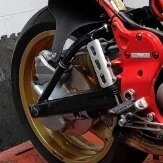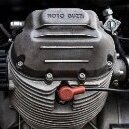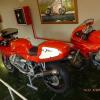
Ryland3210
Members-
Posts
1,033 -
Joined
-
Last visited
-
Days Won
1
Ryland3210 last won the day on August 1 2015
Ryland3210 had the most liked content!
Profile Information
-
My bike(s)
2004 V11 Cafe Sport
Recent Profile Visitors
1,497 profile views
Ryland3210's Achievements

Forum Flooder :) (4/5)
4
Reputation
-
That VDO substitute looks like the ticket. I've been through three speedometer cables. I'm still maintaining the OEM speedo, but I really like the Sigma bike speedometer with its accuracy and many features.
-
Having seen a Guzzisti arrive at a rally on a rainy day with a sheepskin, I got interested in the advantages. I purchased a dense pile pelt, and cut out two pieces to fit my two bikes. I gotta tell ya, it improved the seat comfort dramatically. To hold it in place (in case I want to stand up at high speed), I picked up a beefy set of black suspenders with nickel plated alligator clips and reduced the length so it locates between the rear fender and the frame, and firmly keeps the pelt in place. It's worked very well to eliminate butt abuse on long trips, and prevents the seat from getting scorching hot when parked in the sun.
-
Another option: I have seen clip ons installed in reverse, right to left. It was done to bring them closer, for more comfort. I don't know if this will work with all clip ons, but thought I'd mention it FWIW.
-
Hi Brian, Thanks for the tip on reversing the pattern. I've had no problem with the lever position. I did as thorough an ergonomic study as I could before designing the lever. I have a 31 inch inseam, which I used as a basis. I figured that would work for everyone, given the adjustment range, but I guess there are always exceptions. I also took notice of the existing lever orientation, assuming MG had it optimized, but once again, I guess there are always exceptions.
-
I believe the stock unit is pressure die cast. As such, it is likely to have porosity, which can cause interesting and thrilling mini explosions when heated, as the bubbles build pressure and explode out. In addition, the die casting process freezes the alloy very quickly, resulting in little ductility, but high yield strength. Heating it enough to bend will soften the metal.
-
I really appreciate the kind comments and the caution about adjusting the lever high enough to avoid interference with the pork chop. Not having heard back from Gerard on my email message to him, it didn't occur to me until tonight to check back in with the forum. Since my last post, I have already taken one of the levers to a very skilled welding and fabrication house. They have been supplying welded assemblies to me for many years, for hydraulic systems running as high as 10,000 psi. The best place to do the bending from the ergonomic standpoint would be at the middle of the bend where it is tangent to the pork chop. However, the cross section is a bit thicker there, so it might be tricky. The tooling cost is very high for this casting. There is only one tool. I'm concerned that if I change it, the majority of customers might be unhappy with the result. I have asked the welding/machine shop to consider either bending or cutting out a trapezoidal or triangular section, rewelding it, and then polishing it back for good appearance. Once I have a modified lever (I have specified 2 inches, per Gerard's request), I will try it on my Cafe Sport to see if the lever can then be adjusted high enough for the riders of average inseam. If it is, then the alternative of making a permanent change in the tooling can be compared to providing custom modified levers to those who prefer them. Heaven only knows what these costs will be, but I should know within the next week or two. After selling them all this time, I have only just now paid back the original tooling costs. The challenge is that the small number of units sold for this small market, makes it difficult to provide this kit at a reasonable price. All of my purchased parts and fabrication costs have gone up, while I have held the price constant. I've also absorbed the added cost of some enhancements I've made along the way. However, I do enjoy the project, and appreciate the positive responce and recognition. I've a lot of catching up to do since my trip to Austria, so I may not be heard from very often, but rest assured I'll be working diligently as I described above. Cheers, John
-
Gerard was shipped the latest version of kit, which has a widened range of adjustment with shortened connecting rod, so the connecting rod mod and spline rotation won't help. The limit is where the lever contacts the pork chop on downward stroke. I plan on trying reversing the rotation direction this winter like my Norton had just for fun, and I think it is more logical than today's standard. That won't change the limit either, however. The shift levers are cast, not machined, so changing the tooling is not a simple matter of changing the CNC program. It's an expensive deal. Gerard's kit has the new alloy, which did not require heat treating, so cutting out a trapezoidal or triangular section and welding it back together should not be difficult, and there is no heat treating to be re done afterwards. It is not pressure die cast, so the porosity which could cause problems if it were (like the Moto Guzzi parts, for example) when attempting welding. An alternative might be to work with someone skilled enough with a torch to heat the lever up and bend it. That would probably look better as well. Gerard has contacted me directly, so I'm working with him on a solution. Cheers, John
-
For something completely different, check this out: www.motratech.com
-
The Harley TPS has a slightly different relationship of voltage versus throttle position. The plots of the Harley and Moto Guzzi versions are somewhere in the forum. There are also techical discussions on the effect of the differences. My recollection is that it will work, with the main difference lying in the midrange of position. Mixture and timing advance are affected. If you're interested and cannot find the topics, send me a personal message. I'm traveling just now, but when I get back to home base next week, I can supply you the info. Some riders, including me, have closed off the gap to prevent water from dropping down into the throttle body. Others have said they don't think there is any risk to the sensor. I used gray silicon rubber, and feathered in a fillet with a wet fingertip. It blends in with the aluminum body, and looks like it belongs there. Cheap insurance, in my opinion. regards
-
Hi Skeeve, I love your math. 1.5 + 1.5 = 3. That's true, but subject to misinterpretation. However, if each Nevada piston weighs "n", and each Ti piston weighs "t", the weight of both of the Ti's pistons is: 1.5n + 1.5n = 3n, but n is only half the weight of both Nevada pistons, so the total weight of the Ti's is 1.5 times the total weight of the Nevada's, all other things being equal. That's still a substantial difference. Also, its connecting rods are probably more massive as well. Since the engineering (rather than today's manufacturing) of the big blocks is the subject of the comparison, and took place in the past, it's "were", rather than "are". Happy Independence day!
-
On better A/D converters, the analog input has an independent ground, which would also be the ground reference of the precision 5 volt reference voltage. How is the ground of the TPS connected to the ground of the ECU?
-
Charging system voltages of 14.3 are not unusual under some conditions. 13.8 is OK when temperature is high, but a good regulator will temporarily jack the voltage up right after starting to drive a boost charge back into the battery. Relays designed for automotive use should have no problem at 14.3 volts. As the coil heats up, its resistance increases, reducing current, so that has a self correcting effect. It's possible that the fuel pump has no internal diode or other inductive kickback suppression protection. In that case, every time the pump turns off, it could be zapping the contacts. If the pump is a brush type DC motor or vibrating solenoid, every commutation causes an inductive kickback.
-
I have been using nothing but Yuasa batteries for decades. Self discharge is a fact of life, but I have observed that the battery discharge is much faster on my Guzzi than my Yamaha. I monitor the battery voltage at least once a week during the winter or any other time the bike is not being run for a couple of weeks. I find it simple to monitor, since I have a heated clothing receptacle to connect to. My experience is that the Guzzi requires recharging with a battery tender about every two weeks on the Guzzi. It is important to recharge it before it drops below 50% charge. In rough numbers (they vary with temperature), 100% charge is 12.65 volts, 0% charge is 11.65 volts. The voltage must be measured several hours after the engine is shut off to eliminate the "surface charge", which causes the battery to read higher voltage than what represents the actual state of charge. I usually wait overnight, or run the headlights for a few minutes after stopping the engine to accelerate the discharge of the "surface charge", if I want to know right away. Measure the voltage with the ignition and lights off, however. My practice is to recharge anytime the voltage drops below 12.4. If there is only a conventional charger available, one can calculate how many amp-hours are needed to recharge the battery and do it by time. The charging current should not exceed 10% of the amp hour rating of the battery. For example, my Yuasa is a 15 amp hour unit, so I keep the charge current under 1.5 amps. Oh, one other thing: I use a "smart" battery charger, but do not keep it continuously connected. My preference is to eliminate any risk of overcharging the battery, which can also reduce capacity, by only charging when it is needed. Once a battery is heavily discharged, even a long ride may not fully recharge it. For example, a 15 amp hour battery will require 1.5 amps charging current for 11-12 hours to recharge. When riding, the regulator maintains constant voltage, so once the battery accepts some charge, it will absorb less current at the regulated voltage, so it could well take 24 hours of non-stop riding to fully recharge. Better to use a charger and voltage tests to see where you are. Hope this helps. My Yuasa's have typically lasted several years.
-
I have been using nothing but Yuasa batteries for decades. Self discharge is a fact of life, but I have observed that the battery discharge is much faster on my Guzzi than my Yamaha. I monitor the battery voltage at least once a week during the winter or any other time the bike is not being run for a couple of weeks. I find it simple to monitor, since I have a heated clothing receptacle to connect to. My experience is that the Guzzi requires recharging with a battery tender about every two weeks on the Guzzi. It is important to recharge it before it drops below 50% charge. In rough numbers (they vary with temperature), 100% charge is 12.65 volts, 0% charge is 11.65 volts. The voltage must be measured several hours after the engine is shut off to eliminate the "surface charge", which causes the battery to read higher voltage than what represents the actual state of charge. I usually wait overnight, or run the headlights for a few minutes after stopping the engine to accelerate the discharge of the "surface charge", if I want to know right away. Measure the voltage with the ignition and lights off, however. My practice is to recharge anytime the voltage drops below 12.4. If there is only a conventional charger available, one can calculate how many amp-hours are needed to recharge the battery and do it by time. The charging current should not exceed 10% of the amp hour rating of the battery. For example, my Yuasa is a 15 amp hour unit, so I keep the charge current under 1.5 amps. Hope this helps. My Yuasa's have typically lasted several years.
-
Hi Dave, Nothing lasts forever, but FYI no field failures of Omron's have been reported to date. John





